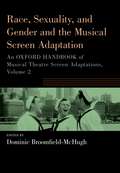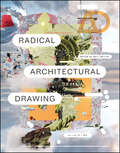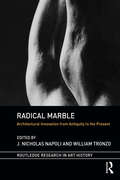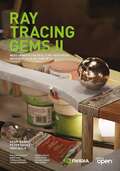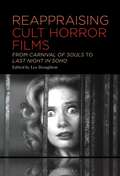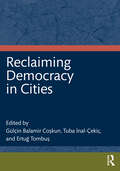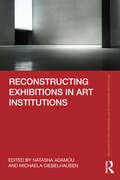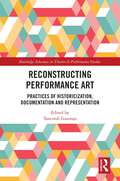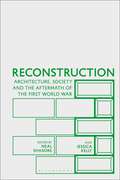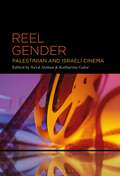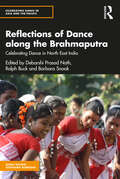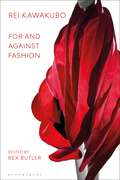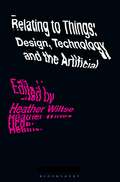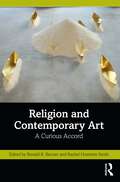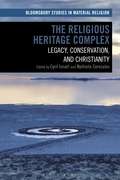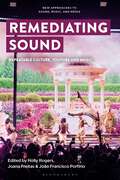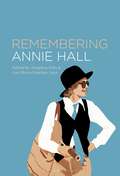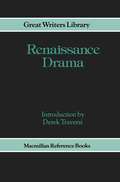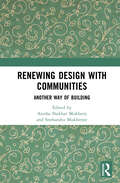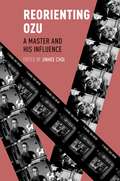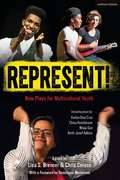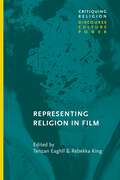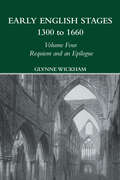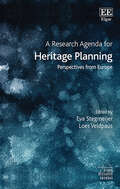- Table View
- List View
Race, Sexuality, and Gender and the Musical Screen Adaptation: An Oxford Handbook of Musical Theatre Screen Adaptations, Volume 2 (OXFORD HANDBOOKS SERIES)
Hollywood's conversion to sound in the 1920s created an early peak in the film musical, following the immense success of The Jazz Singer. The opportunity to synchronize moving pictures with a soundtrack suited the musical in particular, since the heightened experience of song and dance drew attention to the novelty of the technological development. Until the near-collapse of the genre in the 1960s, the film musical enjoyed around thirty years of development, as landmarks such as The Wizard of Oz, Meet Me in St. Louis, Singin' in the Rain, and Gigi showed the exciting possibilities of putting musicals on the silver screen. The second of three volumes, Race, Sexuality, and Gender and the Musical Screen Adaptation: An Oxford Handbook, traces how the genre of the stage-to-screen musical has evolved, focusing in particular of issues of race, gender and sexuality. Enduringly popular adaptations such as Kiss Me Kate and Pal Joey are considered through the lens of identity, while several chapters consider how different adaptations of the same stage musical reflect shifting historical contexts. Together, the chapters incite lively debates about the process of adapting Broadway for the big screen and provide models for future studies. Volume I: The Politics of the Musical Theatre Screen Adaptation Volume II: Race, Sexuality, and Gender and the Musical Screen Adaptation Volume III: Stars, Studios, and the Musical Theatre Screen Adaptation
Radical Architectural Drawing (Architectural Design)
There is a newfound interest in architectural drawing. Some of the most forward-looking architects worldwide are reinventing it to discover the radical possibilities of contemporary architecture as a rich mix of the virtual and the actual. Architectural drawing is adapting to compensate for these new changes to the discipline, and is being used to speculate on new paradigms of space and representation. This AD seeks to showcase the architects who are pushing the envelope of drawing in extraordinary ways, and their insights into architecture&’s future spatial dexterity. The issue is built around an international group of architects involved in an ongoing KU Leuven Faculty of Architecture international drawing research project, who are creating new drawing methodologies in new and exciting realms. Their projects are written about from the perspective of architectural representation by critics and commentators from across the globe, illustrating a cornucopia of graphic verve and talent in this highly contemporary and thought-provoking issue. Contributors: Aaron Betsky, Penelope Haralambidou, Ulrika Karlsson, Michael McGarry, Nicholas de Monchaux, Ricardo de Ostos, Alberto Pérez-Gómez, Peter Salter, Chris L Smith, Wolfgang Tschapeller, Sarah de Villiers, Robin Wilson, and Jason Young. Drawings by: Bryan Cantley, Nat Chard, Peter Cook, Riet Eeckhout, CJ Lim, Perry Kulper, Metis (Mark Dorrian and Adrian Hawker), Shaun Murray, Smout Allen, Neil Spiller, Nada Subotincic, Michael Webb, Mark West, and Michael Young.
Radical Marble: Architectural Innovation from Antiquity to the Present (Routledge Research in Art History)
Marble is one of the great veins through the architectural tradition and fundamental building block of the Mediterranean world, from the Parthenon of mid-fifth century Athens, which was constructed of pentelic marble, to Justinian’s Hagia Sophia in Constantinople and the Renaissance and Baroque basilica of St. Peter’s in the Vatican. Scholarship has done much in recent years to reveal the ways and means of marble. The use of colored marbles in Roman imperial architecture has recently been the subject of a major exhibition and the medieval traditions of marble working have been studied in the context of family genealogies and social networks. In addition, architectural historians have revealed the meanings evoked by marble revetted and paved surfaces, from Heavenly Jerusalem to frozen water. The present volume builds upon the body of recent and emerging research - from antiquity to the present day - to embrace a global focus and address the more unusual (or at least unexpected) uses, meanings, and aesthetic appeal of marble. It presents instances where the use of marble has revolutionized architectural practice, suggested new meaning for the built environment, or defined a new aesthetic - moments where this well-known material has been put to radical use.
Radical Marble: Architectural Innovation from Antiquity to the Present (Routledge Research in Art History)
Marble is one of the great veins through the architectural tradition and fundamental building block of the Mediterranean world, from the Parthenon of mid-fifth century Athens, which was constructed of pentelic marble, to Justinian’s Hagia Sophia in Constantinople and the Renaissance and Baroque basilica of St. Peter’s in the Vatican. Scholarship has done much in recent years to reveal the ways and means of marble. The use of colored marbles in Roman imperial architecture has recently been the subject of a major exhibition and the medieval traditions of marble working have been studied in the context of family genealogies and social networks. In addition, architectural historians have revealed the meanings evoked by marble revetted and paved surfaces, from Heavenly Jerusalem to frozen water. The present volume builds upon the body of recent and emerging research - from antiquity to the present day - to embrace a global focus and address the more unusual (or at least unexpected) uses, meanings, and aesthetic appeal of marble. It presents instances where the use of marble has revolutionized architectural practice, suggested new meaning for the built environment, or defined a new aesthetic - moments where this well-known material has been put to radical use.
Ray Tracing Gems II: Next Generation Real-Time Rendering with DXR, Vulkan, and OptiX
The digital version of this book is available now for free – with the print version following very soon!This Open Access book is a must-have for anyone interested in real-time rendering. Ray tracing is the holy grail of gaming graphics, simulating the physical behavior of light to bring real-time, cinematic-quality rendering to even the most visually intense games. Ray tracing is also a fundamental algorithm used for architecture applications, visualization, sound simulation, deep learning, and more.Ray Tracing Gems II is written by industry experts with a particular focus on ray tracing, and it offers a practical means to master the new capabilities of current and future GPUs with the latest graphics APIs.What You'll Learn:The latest ray tracing techniques for developing real-time applications in multiple domainsCase studies from developers and studios who have shipped products that use real-time ray tracing.Guidance, advice and best practices for rendering applications with various GPU-based ray tracing APIs (DirectX Raytracing, Vulkan Ray Tracing)High performance graphics for 3D graphics, virtual reality, animation, and moreWho This Book Is For:Game and graphics developers who are looking to leverage the latest hardware and software tools for real-time rendering and ray tracing to enhance their applications across a variety of disciplines.
Reappraising Cult Horror Films: From Carnival of Souls to Last Night in Soho
Identifies key – and in some cases previously overlooked – cult horror films from around the world and reappraises them by approaching and interrogating them in new ways.New productions in the horror genre occupy a prominent space within the cinematic landscape of the 21st century, but the genre's back catalogue of older films refuses to be consigned to the motion picture graveyard just yet. Interest in older horror films remains high, and an ever-increasing number of these films have enjoyed an afterlife as cult movies thanks to regular film festival screenings, television broadcasts and home video releases. Similarly, academic interest in the horror genre has remained high. The frameworks applied by contributors to the collection include genre studies, narrative theory, socio-political readings, aspects of cultural studies, gendered readings, archival research, fan culture work, interviews with filmmakers, aspects of film historiography, spatial theory and cult film theory. Covering a corpus of films that ranges from recognised cult horror classics such as The Wicker Man, The Shining and Candyman to more obscure films like Daughters of Darkness, The Legend of the 7 Golden Vampires, Shivers, Howling III: The Marsupials and Inside, Broughton has curated an international selection of case studies that show the diverse nature of the cult horror subgenre. Be they star-laden, stylish, violent, bizarre or simply little heard-of obscurities, this book offers a multitude of new critical insights into a truly eclectic selection of cult horror films.
Reclaiming Democracy in Cities
Effective urban governance is essential in responding to the challenges of inequality, migration, public health, housing, security, and climate change. Reclaiming Democracy in Cities frames the city as a political actor in its own right, exploring the city’s potential to develop deliberative and participatory practices which help inform innovative democratic solutions to modern day challenges.Bringing together expertise from an international selection of scholars from various fields, this book begins with three chapters which discuss the theoretical idea of the democratic city and the real-world applicability of such a model. Part II discusses new and innovative democratic practices at the local level and asks in what way these practices help us to rethink democratic politics, institutions, and mechanisms in order to move toward a more egalitarian, pluralist, and inclusive direction. Drawing on the Istanbul municipal elections and the Kurdish municipal experience, Part III focuses on the question of whether cities and local governments can lead to the emergence of strong democratic forces that oppose authoritarian regimes. Finally, Part IV discusses urban solidarity networks and collaborations at both the local level and beyond the nation, questioning whether urban solidarity networks and alliances with civil society or transnational city networks can create alternative ways of thinking about the city as a locus of democracy.This edited volume will appeal to academics, researchers, and advanced students in the fields of urban studies, particularly those with an interest in democratic theory; local democracy; participation and municipalities. It will also be relevant for practitioners of local governments, NGOs, and advocacy groups and activists working for solidarity networks between cities.
Reconstructing Exhibitions in Art Institutions (Routledge Research in Art Museums and Exhibitions)
Reconstructing Exhibitions in Art Institutions spans exhibition histories as anti-apartheid activism within South African community arts; collectivities and trade unions in Argentina; Civil Rights movements and Black communities in Baltimore; institutional self-critique within the neoliberal museum; reframing feminisms in USA; and revisiting Cold War Modernisms in Eastern Europe among other themes. An interdisciplinary project with a global reach, this edited volume considers the theme of exhibitions as political resistance as well as cultural critique from global perspectives including South Africa, Latin America, Eastern Europe, USA and West Europe. The book includes contributions by ten authors from the fields of art history, social sciences, anthropology, museum studies, provenance research, curating and exhibition histories. The edited volume finally examines exhibition reconstructions both as a symptom of advanced capitalism, geopolitical dynamics and social uprisings, and as a critique of imperial and capitalist violence. Art historical areas covered in the book include conceptualism, minimalism, modern painting, global modernisms, archives and community arts. This volume will be of interest to a wide range of audiences including art historians, curators, gallery studies and museum professionals, and also to scholars and students from the fields of anthropology, ethnography, sociology, and history. It would also appeal to a general public with an interest in modern and contemporary art exhibitions.
Reconstructing Performance Art: Practices of Historicisation, Documentation and Representation (Routledge Advances in Theatre & Performance Studies)
This book investigates the practices of reconstructing and representing performance art and their power to shape this art form and our understanding of it. Performance art emerged internationally between the 1960s and 1970s crossing disciplinary boundaries between performing arts and visual arts. Because of the challenge it posed to the ontologies and paradigms of these fields, performance art has since stimulated an ongoing debate on the most appropriate means to document, preserve and display it. Tancredi Gusman brings together international scholars from different disciplinary fields to examine methods, media, and approaches by which this art form has been represented and (re)activated over time and its transnational history reconstructed. Through contributions and case studies spanning various countries, regions and artistic fields, the authors outline an innovative theoretical-methodological framework for capturing the processes and strategies for transmitting the tangible and intangible heritage of performance art. This book will be of great appeal to students, researchers, and practitioners in the fields of Theatre and Performance Studies as well as Visual Arts and Art History, who have an interest in performance art, its history and presence in the contemporary artistic and cultural landscape.
Reconstruction: Architecture, Society and the Aftermath of the First World War
Reconstruction explores the impact of the First World War on the built environment – examining the immediate and longer term aftermath of the Great War on the architecture of Britain and the British Empire during the interwar years. While much attention has been paid by historians to post-war architectural reconstruction after 1945, the earlier developments of the interwar period (1919-1939) have been comparatively overlooked. This volume reveals how the architectural developments of this period not only provided important foundations for what happened after 1945 – they are also of real significance in their own right.Sixteen essays written by leading and emerging scholars bring together new and diverse approaches to the period – a period of reconstruction, fraught with the challenges of modernity and democratisation. The collection considers the complex effects of reconstruction on design, discourse, practice, and professionalism, and deals with the full spectrum of architectural styles and approaches, privileging neither Modernism nor traditional styles like the neo-Georgian. It brings to the fore social and political histories of the built environment, and makes important postcolonial interventions into the architectural history of British Imperialism at home and in its far reaches; in Cairo, South Africa, Australia, and India.
Reel Gender: Palestinian and Israeli Cinema
Reel Gender is a groundbreaking collection that addresses the collective realities and the filmic representations of Palestinian and Israeli societies. The eight essays, by leading scholars, demonstrate how Palestinian and Israeli film production-despite obvious overlaps and similarities and while keeping in mind the inherent asymmetry of power dynamics-are at the forefront of engaging gender and sexuality. The scholars of this volume construct and deconstruct still and moving images, characters, and stories that create an entanglement of Palestinian and Israeli cinema. Together they portray the region's diverse but unexpectedly intermingled ethnic, religious, and national communities, framed or countered by various societal norms, laws, and expectations, while also defined by colonial realities. The essays draw methodologically from the fields of media and cultural studies, critical and postcolonial theory, feminism, post-feminism, and queer theory.
Reflections of Dance along the Brahmaputra: Celebrating Dance in North East India (Celebrating Dance in Asia and the Pacific)
This volume brings a critical lens to dance and culture within North East India. Through case studies, first-hand accounts, and interviews, it explores unique folk dances of Indigenous communities of North East India that reflect diverse journeys, lifestyles, and connections within their ethnic groups, marking almost every ritual and festival. Dance for people of North East India, as elsewhere, is also a way of declaring, establishing, celebrating, and asserting humans' relationship with nature. The book draws attention to the origins and special circumstances of dances from North East India. It discusses a range of important folk-dance forms alongside classical dance forms in North East India, with a focus on Sattriya dance. The chapters examine how these dance forms play an important role in the region’s socio-cultural, economic, and political life, intertwining religion and the arts through music, dance, and drama. Further, they also explore how folk dance cultures in North East India have never been relegated to the background, never considered secondary, aesthetically, or otherwise, but have become expressions of political and cultural identity. An evocative work, this volume will be of interest to students and researchers of pedagogy, choreography, community dance practice, theatre and performance studies, social and cultural studies, aesthetics, interdisciplinary arts, and more. It will be an invaluable resource for artists and practitioners working in dance schools and communities.
Rei Kawakubo: For and Against Fashion
The Japanese fashion designer Rei Kawakubo of Comme des Garçons is undoubtedly one of the world's major fashion designers. In 2017 she was the second living designer to ever be given a retrospective at the renowned Costume Institute of the Metropolitan Museum of Art in New York. Her work exerts an extraordinary influence over succeeding generations of designers and is a major point of reference for all those wishing to explore the place of fashion in contemporary culture.The 14 essays in this collection, written by eminent fashion theorists from around the world, ask what is the relationship of Kawakubo's work to art, philosophy and architecture, and ultimately illustrate how Kawakubo's creative output allows us to understand the very notion of fashion itself.
Relating to Things: Design, Technology and the Artificial
We relate to things and things relate to us. Emerging technologies do this in ways that are interesting and exciting, but often also inaccessible or invisible. In Relating to Things, leading design researchers and philosophers respond to issues raised by this situation - inquiring into what it means to live with and relate to things that can actively relate to us, and that relate to each other in ways that do not involve us at all.Case studies include Amazon's Alexa, the Internet of Things, Pokémon Go and Roomba the robot vacuum cleaner. Authors explore everything from the care work undertaken by objects, reciprocal human/machine learning, technological mediation as a form of control, and what it takes to reveal things that tend to be hidden and that often (by design) conceal the ways in which they use us.As a whole, the book is a collaborative philosophical inquiry into the nature and consequences of contemporary technological things. It is a design inquiry into the current nature of the artificial, and possibilities for how things might be otherwise.
Religion and Contemporary Art: A Curious Accord
Religion and Contemporary Art sets the theoretical frameworks and interpretive strategies for exploring the re-emergence of religion in the making, exhibiting, and discussion of contemporary art. Featuring essays from both established and emerging scholars, critics, and artists, the book reflects on what might be termed an "accord" between contemporary art and religion. It explores the common strategies contemporary artists employ in the interface between religion and contemporary art practice. It also includes case studies to provide more in-depth treatments of specific artists grappling with themes such as ritual, abstraction, mythology, the body, popular culture, science, liturgy, and social justice, among other themes. It is a must-read resource for working artists, critics, and scholars in this field, and an invitation to new voices "curious" about its promises and possibilities.
The Religious Heritage Complex: Legacy, Conservation, and Christianity (Bloomsbury Studies in Material Religion)
The Religious Heritage Complex examines religious institutions and heritage-making, arguing that the relationship between the two is not as clear-cut as some might think. In fact, the authors show that religious activity has always combined care for the past with conscious practices of heritage-making, which they term “the religious heritage complex.”The book considers the ways patrimony, religion, and identity interact in different contexts worldwide and how religious objects and sites function as identity. It focuses on heritage-making as a religious and material activity for the groups in charge of a religious inheritance, and considers heritage activities as a form of spiritual renewal and transmission. Case studies explore Christian, Afro-Brazilian, Muslim, and Buddhist traditions located in Europe, the Americas, Africa, and Asia. By investigating the longstanding and tightly-enmeshed connections that weave together religion and cultural heritage, this book allows us to think through the ambiguity of religious heritage.
Remediating Sound: Repeatable Culture, YouTube and Music (New Approaches to Sound, Music, and Media)
Remediating Sound studies the phenomena of remixing, mashup and recomposition: forms of reuse and sampling that have come to characterise much of YouTube's audiovisual content. Through collaborative composition, collage and cover songs to reaction videos and political activism , users from diverse backgrounds have embraced the democratised space of YouTube to open up new and innovative forms of sonic creativity and push the boundaries of audiovisual possibilities. Observing the reciprocal flow of influence that runs between various online platforms, 12 chapters position YouTube as a central hub for the exploration of digital sound, music and the moving image. With special focus on aspects of networked creativity that remain overlooked in contemporary scholarship, including library music, memetic media, artificial intelligence, the sonic arts and music fandom, this volume offers interdisciplinary insight into contemporary audiovisual culture.
Remembering Annie Hall
Since its release, Annie Hall has established itself as a key film for Woody Allen's career and the history of romantic comedy more generally. At the 1978 Academy Awards, it won Oscars for Best Film, Best Director, Best Screenplay, and Best Actress and is regularly cited as one of the greatest film comedies ever released, credited with influencing directors such as Wes Anderson, Noah Baumbach, Richard Linklater, Greta Gerwig and Desiree Akhavan. This lively collection brings a new ethical and philosophical perspective to bear on Allen's work quite different from previous generations of scholars.At the same time as exploring the film's continuing influence on contemporary cinema, this book's contributors engage explicitly and implicitly with ongoing debates about Allen's cinematic output following the renewal of accusations against Allen by his adopted daughter Dylan Farrow in 2014 and 2018. The book is alive to debates within film studies about the limits of auteur theory and the role of the spectator.
Renewing Design with Communities: Another Way of Building
This book looks at alternative ways of analyzing traditional and contemporary architectural design and building practices in South Asia with a special focus on India. It showcases how collaborative projects between architects and local communities and drawing from local building traditions can lead to sustainable and equitable practices in architecture. The volume includes an analysis of projects in rural, tribal, and urban areas of India and Nepal and first-hand accounts of architects, teachers, and professionals engaged in the theory and practice of design and architecture. It examines the differences between the individualistic and the collective approach and explores the meaning of architecture as a process and as a product and as a decentralized, ecologically, and locally sensitive way of designing. While comparing traditional and modern methods of building, it also examines the impact of each method on the community, the economy and the surrounding environment. This book will be of interest to researchers and students of architecture, urban studies, urban planning, urban ecology, urban geography, and sustainable development. It will also be useful for architects, planners, urban designers, and professionals associated with these disciplines.
Reorienting Ozu: A Master and His Influence
Considered by many film critics and scholars as a master of Japanese Cinema, director Ozu Yasujiro still inspires filmmakers both within and outside of Japan. With fifteen never before published chapters in English by contributors from North America, Europe, and Japan, Reorienting Ozu explores the Japanese director's oeuvre and his lasting impact on global art cinema. Exploring major theoretical frameworks that characterize Ozu studies, chapters consider the various cultural factors that influenced the director's cinematic output, such as the anxiety of middleclass Japan in the 1930s, the censorship imposed by the US-occupation after World War II, and women's rights in Ozu's late work such as Tokyo Twilight (1957). Ultimately, chapters illuminate Ozu's influence on the directors of Japan and beyond. With the recent restoration and re-release of Ozu's early and late films, this volume provides an opportunity to examine not only the auteur's major works but also the relationships--both cultural and aesthetic--that are forged among directors across the world.
Represent!: New Plays for Multicultural Young People (Plays for Young People)
In their exposé of Gen Z, The New York Times qualified its members as the “most diverse generation in American history". Recent Broadway hits have found a successful formula in productions showcasing the emotional turmoil of contemporary young people, yet the majority of these works represent predominantly white voices, both in terms of authorship and representation. Non-white characters tend to exist only in a world of colorblind casting rather than speaking to their distinct racial and cultural heritage.This anthology helps correct that balance and presents a unique offering of plays written for multicultural teenagers by diverse authors who have spent a significant part of their careers working closely with young people in urban settings. The playwrights - among them award winners such as Chisa Hutchinson and Nilaja Sun - have created texts that are dramatic and comic, satirical and earnest, touchingly real, and amusingly surreal. Varying in length and format, suitable for classrooms and youth groups of all sizes, the plays address such themes as ethnic and cultural identity; ancestry and assimilation; bullying and self-empowerment; disenfranchisement and alienation; parental pressure to over-achieve, youth activism and community-building; and the very real perils of daily school life in an era of gun proliferation.
Representing Religion in Film (Critiquing Religion: Discourse, Culture, Power)
This is the first full-length exploration of the relationship between religion, film, and ideology. It shows how religion is imagined, constructed, and interpreted in film and film criticism. The films analyzed include The Last Jedi, Terminator, Cloud Atlas, Darjeeling Limited, Hellboy, The Revenant, Religulous, and The Secret of my Success. Each chapter offers: - an explanation of the particular representation of religion that appears in film - a discussion of how this representation has been interpreted in film criticism and religious studies scholarship - an in-depth study of a Hollywood or popular film to highlight the rhetorical, social, and political functions this representation accomplishes on the silver screen - a discussion about how such analysis might be applied to other films of a similar genre Written in an accessible style, and focusing on Hollywood and popular cinema, this book will be of interest to both movie lovers and experts alike.
Requiem and an Epilogue
First published in 2002.This volume forms part of the 5 volume set Early English Stages 1300-1660. This set examines the history of the development of dramatic spectacle and stage convention in England from the beginning of the fourteenth century to 1660.
A Research Agenda for Heritage Planning: Perspectives from Europe (Elgar Research Agendas)
Elgar Research Agendas outline the future of research in a given area. Leading scholars are given the space to explore their subject in provocative ways, and map out the potential directions of travel. They are relevant but also visionary.This insightful Research Agenda examines the multidimensional relationship between heritage planning and pressing current societal challenges around climate, identity and development. Mapping future avenues for the field, it suggests new approaches to executing, studying and reflecting on heritage planning. Expert international contributors raise key questions that challenge practice and research to push for structural and institutional change, highlighting how heritage planning, conservation, and adaptive reuse have transformative potential - and the responsibilities that come with such potential. Chapters explore central topics including industrial heritage and conservation planning, digital reconstruction methods and remote sensing technologies, rural tourism, participation and heritage-led regeneration, as well as issues around contestation and politicization, and the conceptualisations of heritage planning.Spanning the domains of theoretical and empirical insights, from academic outlooks to professional challenges, this Research Agenda will be a vital resource for academics and students of urban and human geography, heritage studies, planning, urban design and architecture. Its examination of particular heritage projects will also be useful for policy makers and professionals working in the heritage planning field.
